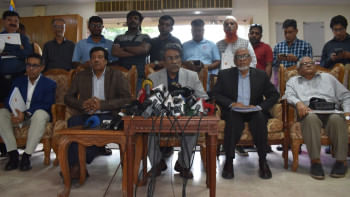Art as a form of resistance: Palestinian artists stand against Israeli occupation

In an interim ruling issued by the International Court of Justice (ICJ) yesterday evening, six provisional measures were ordered in the case filed by South Africa accusing Israel of committing genocide in Gaza, including Israel to take all measures to 'prevent' genocidal acts, 'prevent' and 'punish' the direct and public incitement to genocide, and take immediate and effective steps to ensure the provision of humanitarian assistance to civilians in Gaza.
As of today, at least 26,083 people have been killed and more than 64,400 wounded in Israeli attacks on Gaza since October 7, last year, according to the Palestinian Ministry of Health. Heba Zagout and Muhammed Sami Qariqa– are two of an unknown number of artists, writers and musicians – part of Gaza's surprisingly once-thriving arts scene, whose lives were cut short by the Israeli war machine.

Heba Zagout was an artist and educator who dreamed of peace in Gaza. She spent her life documenting Palestinian heritage and history under Israeli occupation through vibrant acrylic paintings that often featured skylines, homes, and portraits, from her homeland. Her vibrant paintings of Jerusalem's holy sites and Palestinian women wearing traditional embroidered dresses were a way to send a message to the "outside world", the Palestinian artist Heba Zagout said in a video about her work posted online in late September.

Two weeks later, the 39-year-old was killed with two of her children, Adam and Mahmoud, in an Israeli air strike.
Muhammed Sami Qariqa, in a Facebook post on October 14, wrote about shouldering "the responsibility to convey the news and events inside the hospital, capturing a set of painful details with my phone camera including photo, video, voice, writing, and drawing." He was killed in the Al Ahli Arab Hospital explosion that claimed an estimated 500 lives on October 17.
It is evident that despite facing considerable difficulties in the face of a more powerful opponent, Palestinians have shown a remarkable degree of resilience in their determination to subvert the Israeli-imposed order and restore their sovereignty.
For decades, they have employed various means of resistance and methods of struggle in the pursuit of claiming their inherent rights on the historic Palestinian land, and art is one of them.
The art of resistance in the Palestinian
In the face of Israel's ongoing genocide in Gaza, Palestinian artists are wielding their creative prowess as a powerful form of resistance, demanding justice, freedom, and an end to the relentless bloodshed. The canvas becomes a battleground, and the strokes of a paintbrush or the digital graffiti on a screen transform into impassioned voices echoing the struggles of resilient people.
Throughout history, art has been a linchpin in Palestinian resistance, serving as both a means of expression and a tool to assert political existence. The current conflict has once again ignited the flames of creativity amongst Palestinian artists, inspiring them to use their craft to share stories, evoke emotions, and foster solidarity on a global scale.

From the late 19th century to 1948, Palestinian art started taking on a more secular style when artists such as Nicola Saig, Khalid Halabi, and Mubarak Sa'ed left their imprint on the art scene with their impressive paintings. During this phase, Palestinian art was also represented in the Jerusalem art fair called the "First National Arab Fair" by the Palestinian artist Zulfa el-Sa'di. Regarding the thematic focus of Palestinian artworks, paintings mostly revolved around issues related to "identity, memory, location, and resistance." Artworks depicting Palestinian life also included a repertoire of "politically potent icons like the cactus and metaphors such as Palestine as the motherland." With their embodiment of emblematic symbols, paintings pre-1948 provide an insight into the indigenous Palestinian cultural and political existence.

Palestinian art holds a mirror to the political history of Palestine in general. Street art has joined the aforementioned historical context as a new artistic endeavour, whose main importance lies in its ability to serve Palestinians as an instrument of resistance against Israel. By filling the public space with counter-hegemonic visual narratives, Palestinians convey to the Israeli authorities their tenacity and perseverance towards their rights and aspirations. Among its functions, street art acts as a force multiplier for Palestinians, since artworks depicting Palestinian causes serve to stimulate collective emotions and imbue Palestinians with a feeling of togetherness. Especially historically meaningful symbols and icons suffusing street artworks instil in Palestinians a feeling of resistance as well as a determination to struggle.

Leila Khaled is one such Palestinian artist who stands at the forefront of this movement. One of the most expressive graffiti images sketched on the walls in Palestine is a well-known image created by Leila, who is known as a "heroine and iconic figure" in the Palestinian tradition of resistance.
To counter Israel's attempts to portray Palestinian popular figures as terrorists, Palestinians have popularised one of Leila's most remarkable images in their graffiti works. Leila's "Don't Forget the Struggle" indicates a facial expression that exudes hope and optimism and also "rejects the terrorist label." Although her smiling face can be construed as a sign of hope aimed at Palestinians, the image does not omit her militant self, which is signified by the keffiyeh and gun and is clearly aimed at Israel.

Laila Ajjawi is another Palestinian artist who promoted graffiti art as a call for action for women's rights in the Middle East. Her work surpasses traditional boundaries, merging digital art with the raw energy of graffiti to create pieces that resonate with the complexities of Palestinian identity. Laila's artwork focuses on deconstructing gender stereotypes and exploring the plight of Palestinian refugees. Her vibrant, evocative murals catch the eye and inspire contemplation in a non-confrontational manner. Her art encapsulates the urgency of the Palestinian struggle, compelling viewers to confront the stark realities faced by her people.
Jenin Yaseen, a Palestinian painter and illustrator, employs her brush as a weapon against injustice. Yaseen's canvases depict the vibrant hues of Palestinian life, showcasing not only the pain and suffering but also the resilience and beauty that persist amidst adversity. Her art reflects the unyielding spirit of a people determined to preserve their culture and identity against all odds.

Sliman Mansour, a venerable Palestinian artist, contributes to the resistance with his poignant painting titled "Hope". In this masterpiece, Mansour encapsulates the enduring spirit of the Palestinian people, using his brush to paint a vision of hope amidst the chaos. His work serves as a rallying cry for justice, resonating with those who seek an end to the cycle of violence and oppression.
In the realm of documentary photography and skateboarding, Maen Hammad emerges as a multifaceted artiste capturing the essence of Palestinian resistance. Hammad's lens acts as a powerful witness to the everyday struggles faced by Palestinians, documenting the resilience of a community in the face of adversity. His parallel commitment to skateboarding brings an unconventional dimension to his activism, illustrating the defiance of the Palestinian people through unexpected mediums.

One of his collaborative works, "Landing", is a look at the purposeful escape that skateboarding provides to a handful of Palestinian skaters, including Maen Hammad. This purposeful escape is a radical form of resistance to a headspace of violence, situated in the layers of Israeli domination in Palestine. Woven throughout are tales of Maen's family's experience of displacement, diaspora, and partial return. "When I moved back to Palestine in 2014, after living in the US for nineteen years, I brought my skateboard because I knew I would be a stranger. I needed the kid in me to remind myself that all is well while I tried to find home," said the skater in an interview with Magnum Foundation.

Skating is perceived as an interpretive dance with the built environment; a tool to assemble a community; and most importantly, a centering on the imagination. This project serves as a reminder of this pocket of freedom as we all try to find our landing.
From the streets adorned with graffiti to the galleries showcasing powerful paintings, Palestinian artists are using every available platform to amplify their voices. In a world increasingly interconnected through social media and global networks, these artists are ensuring that the plight of their people is not confined to the borders of Gaza but reverberates across continents.
As the world watches the conflict unfold, the canvases of Laila Ajjawi, Jenin Yaseen, Maen Hammad, and Sliman Mansour become visual testaments to the resilience of the Palestinian people. Through their art, they send a resounding message that transcends borders, demanding justice, freedom, and an end to the bloodshed. In the face of adversity, Palestinian artists continue to wield their brushes, cameras, and skateboards as instruments of resistance, using their creativity to shape a narrative that refuses to be silenced.
References:
1. Rhonda A. Saad, "Palestinian Art: From 1850 to the Present by Kamal Boullata," The Arab Studies Journal 18, no. 1 (2010): 331.
2. Tom Segev, One Palestine, Complete, Trans. Haim Watzman (New York: Metropolitan Books, 2000), 16-17
3. Rebecca Gould, "The Materiality of Resistance: Israel's Apartheid Wall in an Age of Globalization," Social Text 118 32, no. 1 (2014): 15

 For all latest news, follow The Daily Star's Google News channel.
For all latest news, follow The Daily Star's Google News channel. 








Comments